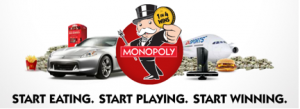Today’s guest post is written by Anne Weiskopf.
I don’t frequent McDonald’s, or any fast food restaurant, but I am a fan of their business model.
They’re a $27 billion dollar company that is not afraid to test customer engagement using social media.
What’s not to like?
A few weeks back Twitter was lit up like the Golden Arches themselves with headlines of a provocative nature FAIL: McDonald’s Hashtag #McDStories Goes Terribly Wrong and Abject Lessons Learnt from McDonald’s Social Media Disaster.
“Did someone get food poisoning?” I wondered. No. But perhaps we’re breathing too much of the same air in the social media bubble.
Practice may not make perfect, but learning and iterating is a blessed event.
This is certainly the case with McDonald’s Monopoly Game, which has been in play for 19 years running.
As of 2008, McDonald’s began leveraging social networks as part of their marketing and communications strategy well before any of their competitors.
More than14,000 stores nationally participate in the annual Monopoly Game and enjoy the benefits of the marketing buzz that drives customers to their stores and the strong in-store results that follow.
And for customers? Last year there were more than 144 million prize winners!
To be fair, unlike grocery shopping (and my experience with Shaw’s Wish Big, Win Big Contest) fast food is inherently a more interesting and fun experience, especially for kids and teens.
It is also a highly competitive market, and with its customer demographics – men, women, and children – it’s a natural fit for in-store promotions and social media outreach.
Marketing and promotions for the Monopoly Game is a fully integrated program that spans television, radio, digital, social, in-store promotions, and point-of-purchase.
For the duration of the month-long game, McDonald’s Facebook page is dedicated to promoting, updating, and interacting with customers playing Monopoly.
Initially their Twitter account was used to build awareness for the contest, but now is also being used to retweet customers who tweet their winnings.
A new and innovative component of McDonald’s social strategy, according to Rick Wion, director of social media, was to use a heat map to visually pinpoint where winners were geographically located. Tweets that include location data were plotted on the heat map, and over time the map changed as more winners were announced.
In terms of results, McDonald’s was able to measure success based upon increases in all of the following metrics:
- Food sold year over year
- Foot traffic to stores
- Website hits
- Facebook likes
- Facebook comments
- Twitter followers
- Number of organic tweets and retweets
- Blog posts
- Positive sentiment
Fun facts about McDonald’s Monopoly include: “Producing 4.2 billion game pieces since 2003 — that’s enough for over 60 percent of the world’s population to have a piece.” (For more facts check out How McDonald’s Monopoly Game Became So Ridiculously Successful)
As McDonald’s continues to expand on new and innovative ways to use social media as a core component of their Monopoly game, Wion has the following advice for Shaw’s and other brands who are launching contests:
Don’t try to do everything at once. When we first added a social media component to Monopoly we used just one channel, which we picked based upon what the research told us would be best. We honed in on that channel, learned from the cycle, and then expanded.
Test, measure, learn, and expand: Sage words for any marketer who is piloting social media for customer engagement; from hashtags to contests.
Anne Weiskopf provides sales and business development services to agencies and companies who are in the social media and technology space. She blogs at Rip Off the Roof. You can follow her on Twitter @AnneWeiskopf.

